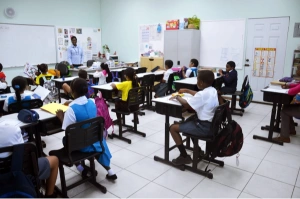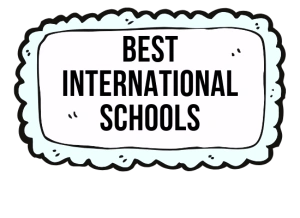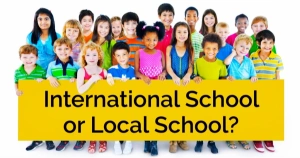Make your school choice by comparing international vs. local schools. Unpack curriculum, language, cost, and other factors. Find the perfect match for your child’s future; this guide covers everything.

Description Of International Schools
International schools are educational institutions that serve a varied student body, usually from different ethnicities and backgrounds. They provide a unique educational experience that distinguishes them from local schools in three crucial ways:
Curriculum:
- Globally recognized curricula: International schools often follow programs like the International Baccalaureate (IB) or Cambridge IGCSE, emphasizing international perspectives, transferable skills, and a focus on critical thinking and problem-solving.
- Multilingual learning: English is often the primary language of instruction, alongside additional language options like French, Spanish, Mandarin, or the local language.
Related: Online International Education: Exploring Virtual Learning
Student Body:
- Cultural diversity: International schools boast a vibrant mix of students from different countries, fostering intercultural understanding, tolerance, and exposure to diverse perspectives.
- Global citizenship: Students learn to navigate and thrive in a multicultural environment, preparing them for an interconnected world.
Related: Technology In International Education 2024

Teaching Approach:
- Inquiry-based learning: International schools prioritize student-centered learning methods that encourage active engagement, collaboration, and critical thinking.
- Holistic development: Education goes beyond academics, encompassing extracurricular activities, sports, the arts, and community service, promoting well-rounded individuals.
Related: Educational Travel Insurance For Students
Additional Distinguishing Features:
- Modern facilities and resources: International schools typically invest in up-to-date technology, libraries, laboratories, and other advanced resources.
- Experienced international faculty: Teachers often possess diverse international backgrounds and qualifications, bringing global expertise to the classroom.
- Strong support system: International schools often offer dedicated guidance counselors, language support, and cultural orientation programs to assist students in adapting to a new environment.
Related: How To Ace Your Exams: 24 Effective Study Strategies

Benefits Of Attending An International School:
- Exposure to different cultures and perspectives.
- Globally recognized education, transferable skills, and international qualifications.
- Development of critical thinking, problem-solving, and communication skills.
- Preparation for higher education and careers in a globalized world.
- Nurturing tolerance, understanding, and acceptance of diversity.
Related: Student Well-being Abroad: 7 Holistic Approaches To Health
However, it’s crucial to consider potential drawbacks:
- Higher tuition fees compared to local schools.
- Possible challenges with adapting to a new language and culture.
- Limited access to local community and cultural immersion experiences.
Ultimately, the decision about whether an international school is right for your child depends on individual needs, preferences, and family circumstances. Carefully weighing the benefits and drawbacks alongside your child’s specific goals and learning style will guide you toward the most suitable educational path.
Related: Future Of Education: 50 Predictions And Trends To Watch In 2024

Description Of Local Schools
Local schools, the cornerstones of our communities, educate children primarily within their national or regional frameworks. While offering distinct differences from international schools, they provide valuable foundations for learning and social development.
Curriculum:
- National focus: Local schools primarily follow nationally mandated curricula, immersing students in local history, language, and cultural values.
- Standardized testing: Preparation for national or regional standardized tests plays a significant role in local school education.
- Locally relevant focus: Curriculums can emphasize regional aspects, preparing students for future involvement in the local community.
- Strong community connection: Local schools offer immersion in the local culture and community, fostering a sense of belonging and familiarity.
- Peer networks and friendships: Students build lasting connections with peers from shared backgrounds, creating a familiar and supportive environment.
Related: DIY Budget-Friendly Decorating Ideas for Student Apartments
Teaching Approach:
- Traditional methods: Local schools often employ well-established teaching methods, focusing on foundational skills and knowledge acquisition.
- Standardized testing preparation: Teaching strategies may prioritize preparation for standardized tests, ensuring national academic benchmarks are met.
Related: Making the Most of Student Credit Cards without Accumulating Debt

Additional Distinguishing Features:
- Accessibility and affordability: Local schools are generally more accessible and affordable than international schools, potentially offering financial benefits.
- Local expertise and experience: Teachers typically possess familiarity with the local culture and educational system, bringing a grounded perspective to the classroom.
- Community connections and partnerships: Local schools often maintain strong ties with community organizations, offering students opportunities for involvement and real-world learning.
Related: Sustainable and Cost-Effective Living Tips for Student Housing
Benefits Of Attending A Local School:
- A strong grounding in national culture and history.
- Development of a sense of community and belonging.
- Building local networks and peer relationships.
- Potential for affordability and accessibility.
- Familiarity with the local educational system and teaching methods.
Related: Planning Affordable Weekend Getaways for College Students
However, it’s important to acknowledge potential drawbacks:
- Limited exposure to diverse cultures and perspectives.
- Curriculums may be less flexible and focused on international comparisons.
- Standardized testing pressure may overshadow individual learning styles.
Local schools play a vital role in shaping citizens rooted in their communities. While they may differ from international schools, they offer unique opportunities for learning, growth, and connection to local values and cultures.
Related: Common Scholarship Application Mistakes To Avoid In 2024

Most Successful Curriculum In The World
Unfortunately, there is no single “most successful” curriculum worldwide. Success is subjective and depends on a variety of elements, such as learning objectives, student demographics, cultural settings, and desired results. However, several curricula continuously rank high in terms of efficacy and international recognition:
Related: Student Insurance: A Wise Investment For College Life
International Baccalaureate(IB):
- It focuses on critical thinking, problem-solving, and transferable abilities.
- Provides internationally recognized qualifications that are valued by colleges worldwide.
- Enhances intercultural awareness and global citizenship.
- It is known for its intellectual rigor and challenge.
Related: Navigating Admission Tests For International Students
Cambridge International Examinations (CIE):
- Provides a flexible framework for multiple curricula, such as IGCSE and A-Levels.
- Places a heavy emphasis on subject knowledge and academic abilities.
- Popular in English-speaking nations and foreign schools.
- Universities around the world recognize this.
Related: Medical School Admission For Aspiring Doctors

Finnish National Curriculum:
- Focuses on student well-being, creativity, and independent learning.
- Uses inquiry-based learning and emphasizes holistic development.
- Ranked highly in international education assessments.
- Known for its innovative approach and focus on equity.
Related: Admission Process For Study Abroad Programs
Singapore Math:
- Renowned for its emphasis on mastery and problem-solving.
- Utilizes concrete visuals and manipulatives to support early learning.
- Delivers strong results in international math assessments.
- Criticized for potential stress and rote learning in lower grades.
Related: 5 Insurance Tips For Parents Of College Students
Montessori Method:
- Promotes self-directed learning and hands-on exploration.
- It focuses on individual development and respect for children’s natural curiosity.
- Emphasizes critical thinking, problem-solving, and social-emotional skills.
- May not be suitable for all learning styles or classroom environments.
Related: Resources For Students With Disabilities: Special Education Admission
Ultimately, the best curriculum for any individual or group depends on specific needs and goals. Consider factors like:
- Target student age and learning levels.
- Desired educational outcomes and skill development.
- Cultural context and local educational requirements.
- Available resources and teaching expertise.
Researching different curricula, consulting with educational experts, and considering your unique environment will help you choose the most suitable and successful program for your specific situation.
Successful curriculum implementation goes beyond the framework itself. Effective teacher training, supportive learning environments, and ongoing adjustments based on student feedback are crucial for maximizing the potential of any program.
Related: International Student Insurance Options For Studying In The U.S

Best International Schools In The World
Determining the world’s “best” foreign schools is subjective and greatly influenced by individual requirements, priorities, and student demographics. However, some schools routinely perform well in multiple categories based on academic excellence, student results, facilities, and the general environment. Here are some instances, organized by region:
Related: Gap Year Adventures: Maximizing Learning Opportunities Abroad
North America:
- Phillips Exeter Academy, USA, is known for its challenging academics, extensive alumni network, and dedication to community service.
- Lawrenceville School, USA, provides a varied academic program with an emphasis on global citizenship and leadership development.
- Upper Canada College, Canada, has a rich history, outstanding facilities, and a thriving arts and athletics community.
Related: Internship Abroad: Gaining Practical Experience While Studying
Europe:
- Lycée Français International Charles de Gaulle, Singapore: The French school is known for its academic rigor and cultural immersion.
- King’s College School, Wimbledon, UK, offers a traditional British education with a strong emphasis on critical thinking and creativity.
- International School of Geneva, Switzerland: Renowned for its international student body, multilingual environment, and innovative teaching methods.
Related: Scholarships For High School Seniors: Planning For Higher Education

Asia:
- Raffles Institution, Singapore: A highly selective institution renowned for its academic brilliance and emphasis on developing future leaders.
- UWCSEA East, Singapore: United World College provides a difficult IB program in a diverse and inclusive setting.
- North Island Secondary School in Hong Kong offers a well-rounded education with an emphasis on academic achievement and personal development.
Related: Reverse Culture Shock After Study Abroad
Australia/Oceania:
- Melbourne Grammar School, Australia: a boys’ school with a strong academic program, numerous extracurricular activities, and a focus on leadership.
- Scots College, Sydney, Australia, provides a comprehensive education with a focus on academic excellence, cultural knowledge, and personal development.
- Auckland Grammar School, New Zealand, is a state-funded school noted for its exceptional academic performance and diverse student body.
Related: Healthcare Scholarships: Pursuing Medical And Nursing Fields
Additional Resources:
- International Baccalaureate Organization (IBO): List of IB World Schools.
- Round Square Conference of Independent Schools: Directory of Round Square Schools.
- BestSchools.net: Global School Rankings.
- The Independent Schools Inspectorate (ISI): UK Independent School Rankings.
The best school for your child depends on their individual needs and goals. Consider factors like academic programs, extracurricular activities, location, school culture, and financial aid options when making your choice. It’s also important to research schools thoroughly and visit them in person if possible.
Related: Winning Scholarships For Community College Students

A Parents’ Guide To Schooling
Raising a child and leading them through their education can seem like a difficult task. Fear not, fellow parent. This book will help you confidently and successfully navigate the many phases of schooling.
Related: Education Loans Or Scholarships: Weighing Your Options
Early Years (Kindergarten through Grade 5):
- Focus on Building Foundations: The early years are critical for developing reading, numeracy, and social-emotional abilities. Play-based learning and discovery pave the way for future academic success.
- Engage in learning: read often, visit museums and libraries, and foster curiosity in everyday encounters. Encourage a love of studying that will last throughout their educational path.
- Nurture Social Skills: Help your child develop healthy friendships, learn conflict resolution, and practice empathy. Strong social skills are vital for academic success and well-being.
- Support Teachers and Schools: Partner with your child’s teachers, attend school events and communicate openly about their progress. Building a strong school-home connection is essential for their success.
Related: Financial Aid For First-Generation College Students
Middle years (grades 6–8):
- Academic Growth and Independence: As students enter middle school, their academic workload grows. Help them develop study skills, time management, and organization. Encourage independence while providing support and advice.
- Exploration of Interests: This is a time for self-discovery, talent development, and experimentation. Encourage extracurricular activities, sports, and hobbies to help them discover their passions.
- Navigating Social Challenges: Middle school brings increased complexity to peer pressure, friendships, and social dynamics. Assist your child in developing healthy communication skills, assertiveness, and resilience as they negotiate these issues.
- Open Communication and Trust: Continue to communicate with your child about their thoughts, feelings, and challenges. Create a trustworthy connection in which they feel safe confiding in you and asking for your help.
Related: Student Housing Options: Finding Your Home Abroad

High School (Grades 9 – 12):
- College and Career Planning: Guide your child in considering their future goals and aspirations. Help them explore different educational and career paths, research colleges and universities, and develop a plan for achieving their goals.
- Academic Rigor and Focus: High school academics become more demanding. Encourage your child to take challenging courses, develop strong study habits, and seek academic support when needed.
- Independence and Responsibility: As your child enters adulthood, encourage them to accept more responsibility for managing their time, finances, and academic demands. Encourage independence while providing advice and support.
- Emotional Support and Self-Care: Managing the pressures of high school can be emotionally taxing. Provide support, encouragement, and a safe environment for them to voice their anxieties and fears. Help them establish good coping mechanisms and self-care practices.
Related: Studying Abroad Packing List: Essentials For International Students
Remember:
- Every child learns and develops at their own pace. Embrace their individualities and tailor your approach to their unique needs and strengths.
- Communication is key. Maintain open dialogue with your child, teachers, and school administrators.
- Celebrate their achievements, big and small. Positive reinforcement and encouragement are essential for their motivation and self-esteem.
- Be their advocate. Support their educational needs and ensure they have access to the resources and support they need to succeed.
This guide is a starting point, not a rigid rulebook. Trust your instincts, adapt your approach to changing circumstances, and enjoy the journey.
Related: Study Abroad Reflection: International Students’ Experiences
Additional Resources:
National Parent-Teacher Association (PTA).
National Association for School Psychologists.
With dedication, support, and open communication, you can guide your child on a successful and rewarding educational journey. Remember, you’re not alone in this. Embrace the challenges, celebrate the milestones, and enjoy the precious moments of watching your child learn and grow.
Related: Staying Connected Using Technology
Conclusion
Choosing the appropriate school is an investment in your child’s future. By carefully assessing your alternatives and prioritizing their needs, you can guarantee that kids obtain the knowledge and experiences they require to develop into confident, well-rounded adults ready to take on the world.

